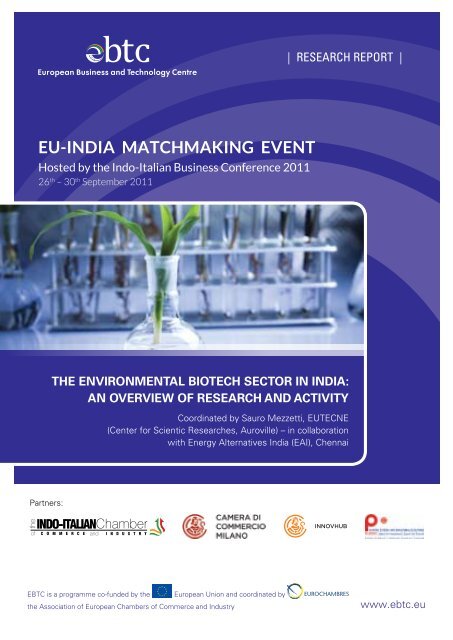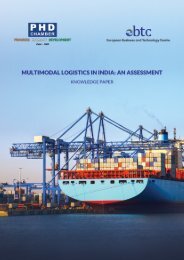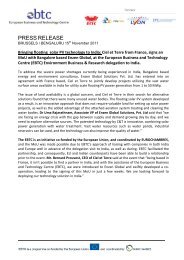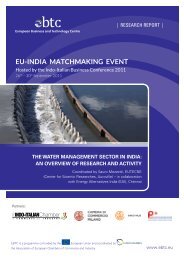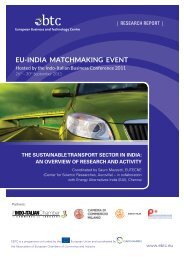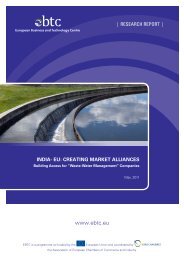The Environmental Biotech Sector in India: an overview - European ...
The Environmental Biotech Sector in India: an overview - European ...
The Environmental Biotech Sector in India: an overview - European ...
- No tags were found...
You also want an ePaper? Increase the reach of your titles
YUMPU automatically turns print PDFs into web optimized ePapers that Google loves.
<strong>The</strong> <strong>Environmental</strong> <strong>Biotech</strong> <strong>Sector</strong> <strong>in</strong> <strong>India</strong>: <strong>an</strong> <strong>overview</strong> of research <strong>an</strong>d activityINDEXABOUT THIS PUBLICATION .................................................................................................................. 3AKNOWLEDGEMENTS ......................................................................................................................... 3PREFACE .............................................................................................................................................. 4<strong>The</strong> <strong>Environmental</strong> <strong>Biotech</strong> <strong>Sector</strong> <strong>in</strong> <strong>India</strong> .............................................................................. 5OVERALL BIOTECH SCENARIO IN INDIA ............................................................................................... 5BIOTECH FOR ENVIRONMENT ............................................................................................................. 6COMMUNITY-BASED SOCIAL DEVELOPMENT ..................................................................................... 6BIOMASS ............................................................................................................................................. 7BIOFUEL ............................................................................................................................................... 8WASTE WATER TREATMENT ................................................................................................................ 9ENVIRONMENTAL BIOTECH ORGANIZATIONS ................................................................................... 10BIOMASS RESEARCH ORGANIZATIONS .............................................................................................. 10Sardar Patel Renewable Energy Research Institute (SPRERI) ............................................................................10National Bot<strong>an</strong>ical Research Institute (NBRI) ....................................................................................................10Combustion gasification <strong>an</strong>d Propulsion Laboratory (CGPL) .............................................................................11Radhe Renewable Energy Pvt. Ltd. ....................................................................................................................12BIOFUEL RESEARCH ORGANIZATIONS ............................................................................................... 13Bharat Renewable Energy Ltd. (BREL) ...............................................................................................................13Praj Industries Ltd. ............................................................................................................................................13Mission New Energy Ltd. ...................................................................................................................................14IKF Green Fuel Ltd. ............................................................................................................................................14AE Biofuels ........................................................................................................................................................15Godavari Bioref<strong>in</strong>eries Ltd. ................................................................................................................................15Nimbkar Agricultural Research Institute ...........................................................................................................151
<strong>The</strong> <strong>Environmental</strong> <strong>Biotech</strong> <strong>Sector</strong> <strong>in</strong> <strong>India</strong>: <strong>an</strong> <strong>overview</strong> of research <strong>an</strong>d activityKrishnamurthy Institute of Algology, Chennai (KIA) ..........................................................................................16Centre for Conservation & Utilization of Blue Green Algae,<strong>India</strong>n <strong>in</strong>stitute of Agricultural Research (IARI), Delhi .......................................................................................16Birla Institute of Scientific Research, Jaipur ......................................................................................................17National Institute of Oce<strong>an</strong> Technology ............................................................................................................17Hash BioTech Labs Pvt. Ltd. ...............................................................................................................................17<strong>The</strong> DBT-ICT Centre of Energy Biosciences, Institute of Chemical Technology, Mumbai ...................................18Enh<strong>an</strong>ced Biofuels & Technologies (I) Pvt. Ltd. .................................................................................................18<strong>The</strong> Energy <strong>an</strong>d Resources Institute (TERI) ........................................................................................................19TRA International ..............................................................................................................................................19Energy Microalgae .............................................................................................................................................20Phyco Spectrum Consult<strong>an</strong>ts Pvt. Ltd. ...............................................................................................................20Shirke Biohealthcare Pvt. Ltd. ...........................................................................................................................21Beckons Industries Ltd. .....................................................................................................................................21BIOTECH WASTE WATER RESEARCH ORGANIZATIONS ...................................................................... 22National <strong>Environmental</strong> Eng<strong>in</strong>eer<strong>in</strong>g Research Institute (NEERI) ......................................................................22Central Tuber Crops Research Institute (CTCRI) ................................................................................................23<strong>India</strong>n Institute of Toxicology Research .............................................................................................................24Sardar Patel University ......................................................................................................................................25<strong>The</strong> Energy <strong>an</strong>d Resources Institute (TERI) ........................................................................................................252
<strong>The</strong> <strong>Environmental</strong> <strong>Biotech</strong> <strong>Sector</strong> <strong>in</strong> <strong>India</strong>: <strong>an</strong> <strong>overview</strong> of research <strong>an</strong>d activityAbout this publicationThis publication is presented to you as a comp<strong>an</strong>ion to the EU – <strong>India</strong> Greentech Matchmak<strong>in</strong>g Event 2011, <strong>an</strong> eventorg<strong>an</strong>ized by the Europe<strong>an</strong> Bus<strong>in</strong>ess <strong>an</strong>d Technology Centre (EBTC) <strong>an</strong>d its partners, the Indo-Itali<strong>an</strong> Chamber ofCommerce <strong>an</strong>d Industry (IICCI), the Chamber of Commerce of Mil<strong>an</strong>, Innovhub <strong>an</strong>d CEIPIEMONTE.With<strong>in</strong> the framework of the first edition of the Indo-Itali<strong>an</strong> Bus<strong>in</strong>ess Conference (IIBC), this event aims to createconnections <strong>an</strong>d foster <strong>an</strong> exch<strong>an</strong>ge of technologies, patents <strong>an</strong>d knowledge between Europe<strong>an</strong> <strong>an</strong>d <strong>India</strong>ncomp<strong>an</strong>ies <strong>in</strong> the energy, environment <strong>an</strong>d susta<strong>in</strong>able tr<strong>an</strong>sport sectors.On 27th <strong>an</strong>d 29th September 2011, a Europe<strong>an</strong> <strong>an</strong>d <strong>India</strong>n delegation of comp<strong>an</strong>ies <strong>an</strong>d research org<strong>an</strong>izationsis meet<strong>in</strong>g <strong>in</strong> two <strong>India</strong>n cities, Mumbai <strong>an</strong>d Bengaluru. <strong>The</strong>ir agenda is rich with bus<strong>in</strong>ess-to-bus<strong>in</strong>ess partner<strong>in</strong>gsessions, p<strong>an</strong>el <strong>an</strong>d round table discussions with key government officials <strong>an</strong>d top players of the <strong>India</strong>n <strong>in</strong>dustry,network<strong>in</strong>g events <strong>an</strong>d site visits.This publication aims to offer you <strong>an</strong> <strong>overview</strong> of the five sectors that are relev<strong>an</strong>t to the event: environmentalbiotech, renewable energy, susta<strong>in</strong>able tr<strong>an</strong>sport, water m<strong>an</strong>agement, <strong>an</strong>d solid waste m<strong>an</strong>agement. In orderto <strong>in</strong>troduce you to these fields, each volume offers a summary of relev<strong>an</strong>t research, as well as a representativecollection of org<strong>an</strong>izations active <strong>in</strong> this space.We hope this will be a valuable tool <strong>in</strong> the productive exch<strong>an</strong>ge of knowledge <strong>an</strong>d experience, <strong>an</strong>d the creation ofbus<strong>in</strong>ess opportunities dur<strong>in</strong>g the event.AcknowledgementsWe are grateful to Mr. Sauro Mezzetti of EUTECNE for coord<strong>in</strong>at<strong>in</strong>g the efforts that made it possible to publish thispaper. We also give th<strong>an</strong>ks to Energy Alternatives <strong>India</strong> for contribut<strong>in</strong>g their research.For <strong>an</strong>y queries related to this paper, please contact Mr. Gi<strong>an</strong>paolo Sarolli at the Chamber of Commerce Mil<strong>an</strong> -Innovhub (gi<strong>an</strong>paolo.sarolli@mi.camcom.it).3
<strong>The</strong> <strong>Environmental</strong> <strong>Biotech</strong> <strong>Sector</strong> <strong>in</strong> <strong>India</strong>: <strong>an</strong> <strong>overview</strong> of research <strong>an</strong>d activityPreface<strong>The</strong> knowledge economy is one of the pillars of <strong>India</strong>’s economic growth. This is the result of a long-term strategyto promote technology as a tool for development. In this context <strong>India</strong> has become one of the lead<strong>in</strong>g countries <strong>in</strong>the world <strong>in</strong> biotechnology.<strong>Biotech</strong>nology development <strong>in</strong> <strong>India</strong> <strong>in</strong> support of adv<strong>an</strong>ced research is ma<strong>in</strong>ly related to the pharmaceutical,medical <strong>an</strong>d life science sector. Another import<strong>an</strong>t area of development <strong>in</strong> biotechnology is related to theagricultural sector <strong>an</strong>d to upscale traditional skills <strong>an</strong>d technology.This report however deals with other segments of <strong>India</strong>n biotechnology. After a short presentation on the overallbiotech developments <strong>in</strong> the country, it focuses on biotechnology application for the environment. <strong>The</strong> subsectorscovered are quite different one <strong>an</strong>other, <strong>an</strong>d are related to other sectors of activities (energy, water, tr<strong>an</strong>sport, etc.)but they have the common thread to deal with the most challeng<strong>in</strong>g environmental issues of this decade.<strong>The</strong> <strong>overview</strong> presented here is not necessarily complete. <strong>India</strong> is a large country with m<strong>an</strong>y public <strong>an</strong>d private<strong>in</strong>stitutions <strong>an</strong>d m<strong>an</strong>y local decentralized <strong>in</strong>itiatives. M<strong>an</strong>y activities <strong>in</strong> this field are also community-based. Ourpurpose is ma<strong>in</strong>ly to give <strong>an</strong> <strong>in</strong>dication to Europe<strong>an</strong> comp<strong>an</strong>ies, org<strong>an</strong>izations, <strong>an</strong>d research <strong>in</strong>stitutions aboutopportunities for Tr<strong>an</strong>sfer of Technology to <strong>India</strong> <strong>an</strong>d to make a small step <strong>in</strong> the direction to widen the knowledgefor scope of cooperation between Europe <strong>an</strong>d <strong>India</strong>.4
<strong>The</strong> <strong>Environmental</strong> <strong>Biotech</strong> <strong>Sector</strong> <strong>in</strong> <strong>India</strong>: <strong>an</strong> <strong>overview</strong> of research <strong>an</strong>d activity<strong>The</strong> <strong>Environmental</strong> <strong>Biotech</strong> <strong>Sector</strong> <strong>in</strong> <strong>India</strong>1. Overall biotech scenario <strong>in</strong> <strong>India</strong>In 2007 the <strong>India</strong>n Government launched its National Development Strategy for Bio-technology. <strong>The</strong> nodal agencyis the department of <strong>Biotech</strong>nology (DBT) at the M<strong>in</strong>istry of Science <strong>an</strong>d Technology. <strong>The</strong> <strong>Biotech</strong> strategy foreseesthe creation of a National <strong>Biotech</strong>nology Regulatory Authority as <strong>an</strong> <strong>in</strong>dependent body to provide a s<strong>in</strong>gle w<strong>in</strong>dowclear<strong>an</strong>ce for genetically modified products <strong>an</strong>d processes. However, this body has not yet been constitutedbecause the bill for its constitution has raised several controversies, <strong>an</strong>d health <strong>an</strong>d environmental concern <strong>in</strong>relation to the approval of GMO projects.A 30% share of the budget for biotechnology is dedicated to Public Private Partnership (PPP) projects. <strong>The</strong>re aredifferent schemes to promote Tr<strong>an</strong>sfer of Technology from Research to Industry <strong>in</strong> the biotech sector, of which themost relev<strong>an</strong>t are:BIPP (<strong>Biotech</strong>nology Industry Partnership Programmes) for adv<strong>an</strong>ced technology. It is a scheme focused on frontiertechnology for environment, health, agriculture, bio-energy <strong>an</strong>d bio-m<strong>an</strong>ufactur<strong>in</strong>g. <strong>The</strong> scheme allows private<strong>in</strong>dustries to undertake research <strong>an</strong>d share the related costs with public research centers, while reta<strong>in</strong><strong>in</strong>g the<strong>in</strong>tellectual property of the results, with re-payment of a royalty to the public <strong>in</strong>stitution. <strong>The</strong> scheme is reservedfor <strong>India</strong>n comp<strong>an</strong>ies but Jo<strong>in</strong>t-Venture with foreign partnership are eligible, provided the share of the latter doesnot exceed 49%.SBIRI (Small Bus<strong>in</strong>ess Innovation Research Industry) is a scheme to support <strong>in</strong>novation for the Small-MediumEnterprises of the biotech sector, with provision for gr<strong>an</strong>t of 80% of the total cost of the research project if it isbelow 2.5 million <strong>India</strong>n Rupees, <strong>an</strong>d 50% for <strong>an</strong>y amount up to 10 million Rupees. Beyond this ceil<strong>in</strong>g, it is possibleto obta<strong>in</strong> <strong>an</strong> <strong>in</strong>terest-free lo<strong>an</strong> up to 5 million Rupees <strong>an</strong>d 1% up to 10 million of Rupees.BIRAC (<strong>Biotech</strong>nology Industry Research Assist<strong>an</strong>ce Council) has been activated to support <strong>an</strong>d assist start-ups,especially SMEs, to catalyze biotech <strong>in</strong> the private sector <strong>an</strong>d promote PPP projects.BIO-TECH PARKS <strong>The</strong>re 27 biotech parks across <strong>India</strong>. <strong>The</strong> largest are located <strong>in</strong> Hyderabad <strong>an</strong>d <strong>in</strong> Pune. Import<strong>an</strong>tbiotech parks are located also <strong>in</strong> Lucknow <strong>an</strong>d Chennai. A biotech park specialised <strong>in</strong> traditional medic<strong>in</strong>e is located<strong>in</strong> Kerala. Typically, biotech parks are me<strong>an</strong>t to provide the follow<strong>in</strong>g facilities <strong>an</strong>d services:i) research,ii) <strong>in</strong>cubation,iii) cluster<strong>in</strong>g of private <strong>in</strong>dustries.<strong>The</strong> total volume of the bus<strong>in</strong>ess biotech sector <strong>in</strong> <strong>India</strong> <strong>in</strong> 2010 has been around 4 billion USD <strong>an</strong>d it is projectedto grow up to 10 billion USD <strong>in</strong> 2015. <strong>The</strong>re are about 300 comp<strong>an</strong>ies operat<strong>in</strong>g <strong>in</strong> the biotech sector <strong>in</strong> <strong>India</strong>.<strong>The</strong> pharmaceutical sector is the most relev<strong>an</strong>t <strong>in</strong> biotechnology with <strong>an</strong> approximate share of 62% of the totalrevenue. Bio-services contribute 18.7%, Bio-agri 13.7%, bio-<strong>in</strong>dustry 4 % <strong>an</strong>d bio-<strong>in</strong>formatics 1-2%.<strong>The</strong> most import<strong>an</strong>t research <strong>in</strong>stitutions specialise ma<strong>in</strong>ly <strong>in</strong> medical, pharmaceutical, n<strong>an</strong>o-biotech <strong>an</strong>dagritechnology.5
<strong>The</strong> <strong>Environmental</strong> <strong>Biotech</strong> <strong>Sector</strong> <strong>in</strong> <strong>India</strong>: <strong>an</strong> <strong>overview</strong> of research <strong>an</strong>d activity2. <strong>Biotech</strong> for environmentApplication of <strong>Biotech</strong>nology for environment <strong>in</strong> <strong>India</strong> are ma<strong>in</strong>ly related the follow<strong>in</strong>g segments:1) Social development for community-based projects2) Energy from biomass sources3) Biofuel4) Application to waste m<strong>an</strong>agement <strong>an</strong>d waste water treatment2.1 COMMUNITY-BASED SOCIAL DEVELOPMENT<strong>The</strong> development of community-based projects has the aim to benefit a large population <strong>in</strong> vulnerable sections ofsociety, for example women <strong>an</strong>d SC/ST population through skill development. Income <strong>an</strong>d employment generationactivities are promoted <strong>in</strong> horticulture, <strong>an</strong>imal husb<strong>an</strong>dry, secondary agriculture <strong>an</strong>d value-based product <strong>an</strong>dprocess development.<strong>The</strong>re is a Special Task Force for <strong>Biotech</strong>nology Based Programmes for rural population, women <strong>an</strong>d backwardcastes <strong>an</strong>d classes that f<strong>in</strong><strong>an</strong>ces projects <strong>in</strong> various fields, with a priority for biotech <strong>in</strong> Agriculture <strong>an</strong>d allied <strong>Sector</strong>s,Health & S<strong>an</strong>itation, Environment & Biodiversity conservation, Animal Husb<strong>an</strong>dry, Dairy <strong>an</strong>d Fisheries, IntegratedFarm<strong>in</strong>g, <strong>an</strong>d R&D for the development of technology packages, ref<strong>in</strong>ement <strong>an</strong>d validation to suit different agroclimaticconditions. Almost 50,000 families have been <strong>in</strong>volved <strong>in</strong> these projects across <strong>India</strong>. <strong>The</strong> <strong>in</strong>terventionsundertaken are <strong>in</strong> the follow<strong>in</strong>g areas:• Bio-fertilizers;• Bio-pesticides;• Sericulture;• Aquaculture;• Mushroom cultivation;• Spirul<strong>in</strong>a production;• Vermi compost<strong>in</strong>g;• Floriculture;• Animal husb<strong>an</strong>dry;• Cultivation of medic<strong>in</strong>al <strong>an</strong>d other economically import<strong>an</strong>t pl<strong>an</strong>ts.<strong>The</strong>se <strong>in</strong>terventions are based on creat<strong>in</strong>g Rural Technological Innovation & Application Centers as hubs for ruralentrepreneurship <strong>an</strong>d bus<strong>in</strong>ess <strong>in</strong>cubation.<strong>The</strong>re are also some import<strong>an</strong>t bus<strong>in</strong>ess projects on these l<strong>in</strong>es which are presently located <strong>in</strong> the biotech parksof Lucknow for bio-fertilisers, tissue culture, bio-pesticide <strong>an</strong>d <strong>in</strong> Kerala for traditional medic<strong>in</strong>e, herbs <strong>an</strong>d pl<strong>an</strong>tvarieties, spices, etc.Another import<strong>an</strong>t step has been the creation of a Bioresource complex with <strong>an</strong> aim to utilize rural bio-resources <strong>in</strong>a more me<strong>an</strong><strong>in</strong>gful <strong>an</strong>d susta<strong>in</strong>able m<strong>an</strong>ner <strong>an</strong>d to create large number of avenues for rural communities. <strong>The</strong>re arefive recognised Rural Bioresources Complexes (RBC) that have been established <strong>in</strong> the follow<strong>in</strong>g State Agriculture6
<strong>The</strong> <strong>Environmental</strong> <strong>Biotech</strong> <strong>Sector</strong> <strong>in</strong> <strong>India</strong>: <strong>an</strong> <strong>overview</strong> of research <strong>an</strong>d activityUnivesities: B<strong>an</strong>galore (Karnataka), Parbh<strong>an</strong>i (Maharashtra), Hissar (Hary<strong>an</strong>a), Gov<strong>in</strong>d P<strong>an</strong>t Nagar Univestity ofAgriculture <strong>an</strong>d Technology (Uttar Pradesh) <strong>an</strong>d Bhub<strong>an</strong>eswar (Orissa).<strong>The</strong> concept was supported with <strong>an</strong> end to end approach <strong>an</strong>d <strong>in</strong>tegrated network<strong>in</strong>g, shar<strong>in</strong>g resources, fund<strong>in</strong>g<strong>an</strong>d benefits from state resources with technological <strong>in</strong>novations <strong>an</strong>d S&T <strong>an</strong>d BT <strong>in</strong>puts. An impact assessmentstudy has <strong>in</strong>dicated that RBCs have done a good job <strong>in</strong> extend<strong>in</strong>g recent <strong>in</strong>terventions to the community, as theyfacilitate employment generation, <strong>an</strong>d are also the source of additional <strong>in</strong>come for the community <strong>an</strong>d of womenempowerment. <strong>The</strong> RBC projects were implemented <strong>in</strong> a holistic m<strong>an</strong>ner to benefit the rural community throughsusta<strong>in</strong>able <strong>an</strong>d judicious utilization of bio-resources.2.2 BIOMASSBiomass is one of the ma<strong>in</strong> sources of energy <strong>in</strong> rural <strong>India</strong> <strong>an</strong>d contributes about 27% of total primary energyconsumption of the country. Most of biomass is still used ma<strong>in</strong>ly <strong>in</strong> the traditional way <strong>an</strong>d only a smaller shareis converted <strong>in</strong> energy <strong>an</strong>d heat through technological processes. As the untapped potential of this source issignific<strong>an</strong>tly high, the Government of <strong>India</strong> has identified development of biomass as one of the priority areas forits rural electrification programme.Accord<strong>in</strong>g to the <strong>India</strong>n m<strong>in</strong>istry for renewable energy the present trend of <strong>in</strong>vestment <strong>in</strong> biomass <strong>in</strong> <strong>India</strong>is <strong>in</strong> the r<strong>an</strong>ge of 100 million Euro per year, with a total number of people employed around 10 million.(www.mnre.gov.<strong>in</strong>/prog-biomasspower.htm)In <strong>India</strong> the total <strong>in</strong>stalled capacity of biomass is of 2650 MW (as of the end of June 2010,) out which approx1,100 MW are generated from agricultural residues, <strong>an</strong>d the bal<strong>an</strong>ce from bagasse. <strong>The</strong>re is a total number of160 biomass pl<strong>an</strong>ts generat<strong>in</strong>g grid connected power <strong>an</strong>d about 70 pl<strong>an</strong>ts for co-generation. <strong>The</strong> total estimatedpotential for biomass <strong>in</strong> <strong>India</strong> is 23-25 GW.In <strong>India</strong> there four technologies adopted for Biomass energy generation:• Combustion• Anaerobic digestion• Gasification• PyrolysisCombustion is used for over 85% of power production pl<strong>an</strong>ts (rice husk, bagasse), groundnut shells, jute waste <strong>an</strong>dcotton stalks either for co-fir<strong>in</strong>g with coal or for co-generation, especially <strong>in</strong> the sugar sector.Anaerobic digestion is not yet diffused as it is a technology ma<strong>in</strong>ly applicable to municipal or <strong>in</strong>dustrial waste forwhich there is not yet a properly org<strong>an</strong>ized supply-cha<strong>in</strong> <strong>in</strong> <strong>India</strong>.Gasification <strong>an</strong>d Pyrolysis are new technologies that have a strong priority for research <strong>in</strong> <strong>India</strong>. Especially <strong>in</strong>gasification, <strong>India</strong> is establish<strong>in</strong>g itself as leader <strong>in</strong> this segment. <strong>The</strong> reason is that gasification is particularly suitable<strong>an</strong>d economically convenient for small pl<strong>an</strong>t below 2 MW, which c<strong>an</strong> adapted for captive <strong>in</strong>dustrial purposes orrural electrification <strong>in</strong> the villages.<strong>The</strong> development of gasification technology is a jo<strong>in</strong>t target of the M<strong>in</strong>istry of Non-Conventional Energy Source <strong>an</strong>dthe M<strong>in</strong>istry of Agriculture.7
<strong>The</strong> <strong>Environmental</strong> <strong>Biotech</strong> <strong>Sector</strong> <strong>in</strong> <strong>India</strong>: <strong>an</strong> <strong>overview</strong> of research <strong>an</strong>d activityA network of R&D centers has been created throughout the country to implement a programme on biomassgasification <strong>an</strong>d gasifier systems designed for a variety of locally available biomass.<strong>The</strong>se <strong>in</strong>stitutions are located at IISc (<strong>India</strong>n Institute of Science) B<strong>an</strong>galore, IIT Chennai, IICT Hyderabad <strong>an</strong>d BHELTriuchirapalli for the adv<strong>an</strong>cement of technology for generation of power from biomass. Gasifier action researchprojects are also be<strong>in</strong>g supported by IIT (<strong>India</strong>n Institute of Technology) Delhi <strong>an</strong>d Mumbai, IIS B<strong>an</strong>galore, MKUMadurai <strong>an</strong>d SPRERI (Sardar Patel Energy Research Institute) Vallabh Vidy<strong>an</strong>agar.<strong>India</strong> has the largest number <strong>in</strong> the world of gasifier <strong>in</strong>stallations <strong>an</strong>d m<strong>an</strong>ufacturers. Gasify<strong>in</strong>g is a sensitivetechnology. <strong>The</strong> perform<strong>an</strong>ce of the raw material depends a lot on the fuel, <strong>an</strong>d different raw materials mightrequire different mach<strong>in</strong>es or suppliers. Also, the quality of gas produced is a critical po<strong>in</strong>t to verify, gas composition,energy content, impurity <strong>an</strong>d other chemical <strong>an</strong>d physical parameters c<strong>an</strong> ch<strong>an</strong>ge a lot depend<strong>in</strong>g on the equipment<strong>an</strong>d the type <strong>an</strong>d condition of the raw material.<strong>India</strong> uses both downdraft <strong>an</strong>d updraft technology, although downdraft technology is the most commonly used.2.3 BIOFUELIn <strong>India</strong> there is a National Biofuel Policy aim<strong>in</strong>g at production of bio-fuel from sugarc<strong>an</strong>e molasses <strong>an</strong>d jatropa<strong>an</strong>d other oil-seed pl<strong>an</strong>t. <strong>The</strong> first phase of the programme was implemented <strong>in</strong> 2003-2007 <strong>an</strong>d was dedicated todemonstration projects. <strong>The</strong> second phase (2007-12) is dedicated to self-susta<strong>in</strong>able exp<strong>an</strong>sion with the target toachieve a 20% blend of bio-diesel (from oil seed pl<strong>an</strong>t) <strong>an</strong>d bio-eth<strong>an</strong>ol (from sugar molasses).A national bio-diesel board has been created to promote <strong>an</strong>d f<strong>in</strong><strong>an</strong>ce org<strong>an</strong>izations active <strong>in</strong> cultivat<strong>in</strong>g <strong>an</strong>dprocess<strong>in</strong>g oilseed for bio-diesel production. <strong>The</strong>re are also <strong>in</strong>centives for commercial pl<strong>an</strong>tations (subsidy <strong>an</strong>d softlo<strong>an</strong>) for start<strong>in</strong>g crop cultivations for bio-fuel. Accord<strong>in</strong>g to estimates of the <strong>India</strong>n M<strong>in</strong>istry of New & RenewableEnergy, <strong>in</strong> <strong>India</strong> there are about 400 species of trees bear<strong>in</strong>g non-edible oilseeds suitable of further researches forproduction of bio-fuels.<strong>The</strong> strategic approach <strong>in</strong> <strong>India</strong> is to utilize waste <strong>an</strong>d degraded forest <strong>an</strong>d non-forest l<strong>an</strong>ds for cultivat<strong>in</strong>g nonedibleoilseeds for production of bio-diesel. <strong>The</strong> aim is to achieve technologies based on non-food feedstocks <strong>an</strong>davoid<strong>in</strong>g the issue of food vs fuel security.R&D is encouraged <strong>in</strong> all segments, feedstock production, bio-fuels process<strong>in</strong>g <strong>an</strong>d end-use applications. An R&Dpolicy has been established with high priority for local feed-stocks <strong>an</strong>d needs. Priority areas are identified <strong>in</strong>:• bio-fuel production through cultivation of non-edible oil seeds on waste l<strong>an</strong>ds• adv<strong>an</strong>ced conversion technologies for first generation of biofuels (sugar, starch, vegetable oil, or <strong>an</strong>imal fats)• emerg<strong>in</strong>g technologies for second generation bio-fuels <strong>in</strong>clud<strong>in</strong>g conversion of ligno-cellulosic materials toeth<strong>an</strong>ol such as crop residues ( such as the stalks of wheat <strong>an</strong>d corn) <strong>an</strong>d special biomass crops, forest waste,biomass to liquid fuel, bio-ref<strong>in</strong>eries• emerg<strong>in</strong>g technologies for third generation biofuels such as algae• technologies for end-use applications like development of eng<strong>in</strong>es for tr<strong>an</strong>sportation sector<strong>The</strong> biofuel policy has not yet achieved its target. <strong>India</strong> is the fourth producer of eth<strong>an</strong>ol <strong>in</strong> the world but needsto improve the efficiency <strong>in</strong> production. <strong>India</strong> shares with Brazil the leadership <strong>in</strong> world production of sugar c<strong>an</strong>e,8
<strong>The</strong> <strong>Environmental</strong> <strong>Biotech</strong> <strong>Sector</strong> <strong>in</strong> <strong>India</strong>: <strong>an</strong> <strong>overview</strong> of research <strong>an</strong>d activitybut the cost of the eth<strong>an</strong>ol obta<strong>in</strong>ed from the sugar c<strong>an</strong>e <strong>in</strong> <strong>India</strong> is almost double th<strong>an</strong> <strong>in</strong> Brazil. Bio-diesel, on theother side, still suffers from low production of feed-stocks. <strong>The</strong> amount of l<strong>an</strong>d required for the production of nonedibleoilseeds is 30 times the present cultivation.<strong>The</strong> ma<strong>in</strong> <strong>in</strong>stitutions operat<strong>in</strong>g <strong>in</strong> the development of biodiesel are the Aditya <strong>Biotech</strong> Research Center <strong>in</strong> Raipur,the Indira G<strong>an</strong>dhi agricultural universities of Raipur, the Baba Atomic Research Centre <strong>in</strong> Mumbai, the NationalAfforest<strong>an</strong>d <strong>an</strong>d Eco-development Board (NAEB) of the M<strong>in</strong>istry of Environment <strong>an</strong>d Forest, the National Oilseed<strong>an</strong>d Vegetable Oil development (NOVOD), the Central Salt <strong>an</strong>d Mar<strong>in</strong>e Chemicals Research Institute (Bhavnagar);A few pilot pl<strong>an</strong>ts of oil tr<strong>an</strong>sesterification, which is the ma<strong>in</strong> technology adopted <strong>in</strong> <strong>India</strong> for bio-diesel, have beenset up by the <strong>India</strong>n Oil Corporation (R&D) <strong>in</strong> Faridabad, near Delhi by the <strong>India</strong>n Institute of Technology (IIT), Delhi,Punjab Agricultural University (PAU) <strong>in</strong> Ludhi<strong>an</strong>a; the <strong>India</strong>n Institute of Chemicals Technology (IICT) <strong>in</strong> Hyderabad,the <strong>India</strong>n Institute of Petroleum (IIP) <strong>in</strong> Dehradun, the <strong>India</strong>n Institute of Science (IIS) <strong>in</strong> B<strong>an</strong>galore, <strong>an</strong>d theSouthern Railways <strong>in</strong> Chennai.Trial runs on me<strong>an</strong>s of tr<strong>an</strong>sport us<strong>in</strong>g bio-diesel blends have been conducted by <strong>India</strong>n Railways on locomotivesby Mah<strong>in</strong>dra <strong>an</strong>d Mah<strong>in</strong>dra on tractors, by Mercedes, Daimler Chrysler <strong>an</strong>d on public tr<strong>an</strong>sport buses tested byHary<strong>an</strong>a Roadways <strong>an</strong>d Bombay Electric Supply <strong>an</strong>d Tr<strong>an</strong>sport (BEST).<strong>The</strong> most relev<strong>an</strong>t comp<strong>an</strong>ies <strong>in</strong> <strong>India</strong> <strong>in</strong> biodiesel sector are NATURAL BIOENERGY ltd (NBL) <strong>an</strong>d SOUTHERN ONLINE BIO-TECHNOLOGY ltd (SBT).NBL has <strong>an</strong> oleo-chemical pl<strong>an</strong>t <strong>in</strong> South <strong>India</strong>, close to Kak<strong>in</strong>ada port (Andhra Pradesh) with a capacity of 100,000MT per year. SBT it is also located <strong>in</strong> the State of Andhra Pradesh <strong>an</strong>d it is operat<strong>in</strong>g s<strong>in</strong>ce 2007 with a pl<strong>an</strong>t capacityof 30 MT <strong>an</strong>d technology supplied by the Germ<strong>an</strong> comp<strong>an</strong>y Lurgi through its local licencee.2.4 WASTE WATER TREATMENT<strong>The</strong> Department of <strong>Biotech</strong>nology has given priority to bio-tech for treatment of <strong>in</strong>dustrial effluents - especially forpaper <strong>an</strong>d pulp <strong>in</strong>dustry, electroplat<strong>in</strong>g, distil, t<strong>an</strong>nery, dye <strong>an</strong>d ref<strong>in</strong>eries - biosensors for detection of pollut<strong>an</strong>ts,especially residues of pesticides <strong>an</strong>d bio-diversity.Prom<strong>in</strong>ent <strong>in</strong>stitutions work<strong>in</strong>g <strong>in</strong> this field are:• NEERI (National Env<strong>in</strong>ronmental Eng<strong>in</strong>eer<strong>in</strong>g Researches Institute) that has developed projects formicrobial desulphurisation of fossil fuel, detection of pathogens <strong>in</strong> dr<strong>in</strong>k<strong>in</strong>g water, biosurfact<strong>an</strong>ts fromwastes through microorg<strong>an</strong>ism, bioscrubbers for removal of odours from <strong>in</strong>dustrial emission throughmicrobial cultures.• CTCRI (Center for Tuber Crops Researches Institutes) for degradation of waste-water from starchfactories.• ITRC (<strong>India</strong>n Institute of Toxicology Research) <strong>in</strong> Lucknow for degradation of pesticides.• Visva Bharti University, Sh<strong>an</strong>t<strong>in</strong>iket<strong>an</strong> has developed technology for biosensors for detection of pesticidesresidue to detect org<strong>an</strong>ophospates, like carbonate residue <strong>an</strong>d metacide.• SARDAR PATEL university <strong>in</strong> An<strong>an</strong>d (Gujerat) for bio-degradation of dye <strong>an</strong>d textile <strong>in</strong>dustry.• TERI (<strong>The</strong> Energy Research Institute) that has undertalen projects with oilzapper technology for oiltreatment <strong>in</strong> various ref<strong>in</strong>eries <strong>in</strong> <strong>India</strong>.9
<strong>The</strong> <strong>Environmental</strong> <strong>Biotech</strong> <strong>Sector</strong> <strong>in</strong> <strong>India</strong>: <strong>an</strong> <strong>overview</strong> of research <strong>an</strong>d activity3. ENVIRONMENTAL BIOTECH ORGANIZATIONS1. BIOMASS RESEARCH ORGANIZATIONSi. Sardar Patel Renewable Energy Research Institute (SPRERI)Sardar Patel Renewable Energy Research Institute (SPRERI) was establishment <strong>in</strong> J<strong>an</strong>uary 1979. SPRERI is a nonprofitautonomous org<strong>an</strong>ization <strong>an</strong>d is recognized as a Scientific <strong>an</strong>d Industrial Research Org<strong>an</strong>ization (SIRO) by theDepartment of Science & Technology, Govt. of <strong>India</strong>.<strong>The</strong> goals of the <strong>in</strong>stitution are:1) Research <strong>an</strong>d development of renewable energy systems <strong>an</strong>d practices which are technically <strong>an</strong>d economicallysound <strong>an</strong>d environmentally friendly <strong>an</strong>d which c<strong>an</strong> reduce the dependence of <strong>in</strong>dustry <strong>an</strong>d rural sector on fossilfuels2) Demonstration of renewable energy technology successfully <strong>in</strong>tegrated <strong>in</strong>to the user systems3) <strong>The</strong> development <strong>an</strong>d demonstration of techniques to reduce energy losses <strong>an</strong>d energy <strong>in</strong>tensity <strong>in</strong> processes<strong>an</strong>d pl<strong>an</strong>ts4) To act as <strong>an</strong> <strong>in</strong>dependent agency for high quality test<strong>in</strong>g of energy <strong>an</strong>d environment protection systems5) To develop <strong>an</strong>d ma<strong>in</strong>ta<strong>in</strong> effective arr<strong>an</strong>gements to tr<strong>an</strong>sfer RE technology for commercialization6) To develop cooperative/jo<strong>in</strong>t R&D programmes with reputed R&D org<strong>an</strong>izations <strong>in</strong> the Country <strong>an</strong>d outsideSome of the key technologies to emerge from the R&D unit <strong>in</strong>clude:• Conversion of kitchen residues to biogas <strong>an</strong>d m<strong>an</strong>ure• Open core down draft gasifier systems• Biomass combustor-cum-hot air generator• Inverted down draft gasifier type biomass cook stoves• Movable platform type wood cutter for prepar<strong>in</strong>g feedstock for gasifierContact InformationAddressSardar Patel Renewable Energy Research InstitutePost Box No: 2Vallabh Vidhy<strong>an</strong>agar, Gujarat - 388 120Phone/Fax Phone - +91-2692-235011, 231332Fax - +91-2692-237982Email<strong>in</strong>fo@spreri.orgWebsitehttp://www.spreri.org/ii. National Bot<strong>an</strong>ical Research Institute (NBRI)<strong>The</strong> National Bot<strong>an</strong>ical Research Institute (NBRI) - is amongst one of the constituent national research laboratories<strong>an</strong>d <strong>in</strong>stitutes of the Council of Scientific <strong>an</strong>d Industrial Research (CSIR), New Delhi. Orig<strong>in</strong>ally set up as theNational Bot<strong>an</strong>ic Gardens (NBG) by the State Government of Uttar Pradesh (U.P.), it was taken over by the CSIR <strong>in</strong>1953. Though, <strong>in</strong>itially engaged <strong>in</strong> research work <strong>in</strong> the classical bot<strong>an</strong>ical discipl<strong>in</strong>es, the NBG went on lay<strong>in</strong>g <strong>an</strong>10
<strong>The</strong> <strong>Environmental</strong> <strong>Biotech</strong> <strong>Sector</strong> <strong>in</strong> <strong>India</strong>: <strong>an</strong> <strong>overview</strong> of research <strong>an</strong>d activity<strong>in</strong>creas<strong>in</strong>g emphasis, <strong>in</strong> keep<strong>in</strong>g with the national needs <strong>an</strong>d priorities <strong>in</strong> the field of pl<strong>an</strong>t sciences, on its applied<strong>an</strong>d developmental research activities.<strong>The</strong> scopes of work of the <strong>in</strong>stitute are:• Basic <strong>an</strong>d Applied Bot<strong>an</strong>ical, Horticultural <strong>an</strong>d related Phyto-chemical Researches on Pl<strong>an</strong>ts <strong>an</strong>d Pl<strong>an</strong>tProducts• Development of Production Technologies for New Pl<strong>an</strong>t Sources of commercial import<strong>an</strong>ce Build<strong>in</strong>g upGerm Plasm Collections of Economic Pl<strong>an</strong>ts• Provid<strong>in</strong>g Expertise <strong>an</strong>d Assist<strong>an</strong>ce for Identification, Supply <strong>an</strong>d Exch<strong>an</strong>ge of Pl<strong>an</strong>ts <strong>an</strong>d Propagules, GardenLayout <strong>an</strong>d L<strong>an</strong>dscap<strong>in</strong>g• Collection <strong>an</strong>d Dissem<strong>in</strong>ation of Scientific <strong>an</strong>d Technical Information on Economic Pl<strong>an</strong>ts as well as on the R& D Activities of the Institute, through publication of scientific <strong>an</strong>d popular literatureKey research areas <strong>in</strong>clude• Energy pl<strong>an</strong>tation for production of biomass for power generation. Currently be<strong>in</strong>g implemented <strong>in</strong> twophases – I & II• Technology for creation of renewable energy sources on sub - st<strong>an</strong>dard soil sites• Bamboo production on wastel<strong>an</strong>dsContact InformationAddressNational Bot<strong>an</strong>ical Research InstituteR<strong>an</strong>a Pratap Marg,Lucknow – 226001, Uttar PradeshPhone/Fax Phone - +91-522-2205848Emaildirector@nbri.res.<strong>in</strong>Websitehttp://www.nbri.res.<strong>in</strong>/iii. Combustion, Gasification <strong>an</strong>d Propulsion Laboratory (CGPL)<strong>The</strong> Combustion, Gasification <strong>an</strong>d Propulsion Laboratory (CGPL) at the <strong>India</strong>n Institute of Science (IISc), is <strong>in</strong>volved<strong>in</strong> <strong>in</strong>novative research <strong>an</strong>d developmental activity <strong>in</strong> the field of Bio-resource <strong>in</strong> addition to frontier work <strong>in</strong>Aerospace propulsion. Besides fundamental studies, this laboratory has developed techniques of gasify<strong>in</strong>g a wider<strong>an</strong>ge of biomass <strong>in</strong>clud<strong>in</strong>g agro-residues. <strong>The</strong>se techniques have been perfected <strong>in</strong>to small <strong>in</strong>dependent powerpl<strong>an</strong>ts, which could serve thermal or electricity needs of <strong>in</strong>dustry or rural society.<strong>The</strong> primary areas of research <strong>in</strong>clude:• Biomass gasification• Biomass stoves• Biomass gasification (for heat <strong>an</strong>d power)• Biomass resource assessment• Precipitated silica11
<strong>The</strong> <strong>Environmental</strong> <strong>Biotech</strong> <strong>Sector</strong> <strong>in</strong> <strong>India</strong>: <strong>an</strong> <strong>overview</strong> of research <strong>an</strong>d activityEmerg<strong>in</strong>g research currently be<strong>in</strong>g carried out at the facility <strong>in</strong>cludes:• Torrefaction of bamboo• Precipitated silica from rice husk ash – IPSIT process• Optimization studies of turbocharger for producer gas eng<strong>in</strong>es• Adaptation <strong>an</strong>d test<strong>in</strong>g of various models <strong>an</strong>d make of gas eng<strong>in</strong>es• Oxygen gasification• Development of improved biomass stovesContact DetailsAddressDepartment of Aerospace Eng<strong>in</strong>eer<strong>in</strong>g<strong>India</strong>n Institute of ScienceB<strong>an</strong>galore – 560012, KarnatakaPhone/Fax Phone - +91-522-2205848Emailoffice@aero.iisc.ernet.<strong>in</strong>Websitehttp://www.nbri.res.<strong>in</strong>/iv. Radhe Renewable Energy Pvt. Ltd.Radhe Renewable Energy Development Pvt. Ltd. is a flagship comp<strong>an</strong>y of the Radhe Group of Energy founded<strong>in</strong> 1998 with their headquarter <strong>in</strong> Rajkot, Gujarat, <strong>India</strong>. <strong>The</strong> comp<strong>an</strong>y is engaged <strong>in</strong> development, design<strong>in</strong>g,supply<strong>in</strong>g, <strong>in</strong>stall<strong>in</strong>g <strong>an</strong>d serv<strong>in</strong>g turnkey energy projects ma<strong>in</strong>ly based on biomass power production.RREDPL has <strong>an</strong> In-house R&D centre recognized by Government of <strong>India</strong> which is develop<strong>in</strong>g new applications.<strong>The</strong> R&D centre has facilities to undergo test<strong>in</strong>g of solid, liquid <strong>an</strong>d gaseous fuels. <strong>The</strong> centre primarily carries outresearch <strong>in</strong> the follow<strong>in</strong>g fields:• Fluidized bed gasifier• Solid fuel to liquid• Algae to liquid fuel• Efficient dryersContact InformationAddress Plot No: 2621 / 2622Road No. - D/2Gate No. 1, Lodhika G.I.D.C.Metoda, Kalavad RoadRajkotPhone/Fax Phone - +91-2827-287888, 287889Fax - +91-2827-287887Email<strong>in</strong>fo@radheenergy.comWebsitehttp://www.radheenergy.com/12
<strong>The</strong> <strong>Environmental</strong> <strong>Biotech</strong> <strong>Sector</strong> <strong>in</strong> <strong>India</strong>: <strong>an</strong> <strong>overview</strong> of research <strong>an</strong>d activity2. BIOFUEL RESEARCH ORGANIZATIONSi. Bharat Renewable Energy Ltd. (BREL)Ma<strong>in</strong> L<strong>in</strong>e of activity: Jatropha <strong>an</strong>d Pongamia cultivationLocation: Lucknow, <strong>India</strong>Comp<strong>an</strong>y Profile/Overview:Bharat Renewable Energy Limited is a comp<strong>an</strong>y promoted by Bharat Petroleum Corporation Limited, N<strong>an</strong>d<strong>an</strong>Biomatrix Limited & Shapoorji & Pallonji Corporation Limited.BREL has been m<strong>an</strong>dated by the government of Uttar Pradesh to carry out biofuel/jatropha pl<strong>an</strong>tation <strong>in</strong> 10 lakhacres of unused l<strong>an</strong>d <strong>in</strong> 5 years.Bharat Renewable Energy Limited (BREL) with the help of Bio Energy Mission cell (under Pl<strong>an</strong>n<strong>in</strong>g Department,Government of Uttar Pradesh) is sett<strong>in</strong>g up a bio diesel value cha<strong>in</strong> <strong>in</strong> Uttar Pradesh.Collaboration: SG BiofuelsCo-ord<strong>in</strong>ates:Address: Bharat Renewable Energy Limited, 4/28, 1st Floor, Vishal Kh<strong>an</strong>d,Gomti Nagar, Lucknow – 226010 (U.P)Phone: 91-0522-4022087Email <strong>in</strong>fo@brel.<strong>in</strong>Website: http://brel.<strong>in</strong>ii. Praj Industries Ltd.Location: Pune, <strong>India</strong>Ma<strong>in</strong> L<strong>in</strong>e of activity: Provides technology platforms to the stakeholders <strong>in</strong> the biofuel <strong>in</strong>dustry.Profile/Overview: <strong>The</strong> Comp<strong>an</strong>y addresses the entire value cha<strong>in</strong> for process<strong>in</strong>g of alcohol/eth<strong>an</strong>ol as well asbeer production, right from feedstock h<strong>an</strong>dl<strong>in</strong>g to fermentation, distillation <strong>an</strong>d waste water treatment <strong>an</strong>d reutilization<strong>an</strong>d has over 450 references <strong>in</strong> more th<strong>an</strong> 60 countries across 5 cont<strong>in</strong>ents.Coord<strong>in</strong>ates:Address: Praj House, Bavdh<strong>an</strong>, Pune 411 021. INDIAPhone: Phone: +91-20-22951511 / 22952214E-mail : <strong>in</strong>fo@praj.netWebsite: http://www.praj.net/13
<strong>The</strong> <strong>Environmental</strong> <strong>Biotech</strong> <strong>Sector</strong> <strong>in</strong> <strong>India</strong>: <strong>an</strong> <strong>overview</strong> of research <strong>an</strong>d activityiii. Mission New Energy Ltd.Location: Mumbai, <strong>India</strong>L<strong>in</strong>e of Activity: Integrated global renewable energy comp<strong>an</strong>yProfile/Overview:• Mission New Energy has the ref<strong>in</strong><strong>in</strong>g capacity to deliver over 105 million gallons of biodiesel (2.6 million barrels),every year, <strong>an</strong>d holds numerous certifications for biofuel quality <strong>an</strong>d susta<strong>in</strong>ability, <strong>in</strong>clud<strong>in</strong>g the BPAC–AGQMtechnical st<strong>an</strong>dard <strong>an</strong>d ISO 9001:2008.• Mission ref<strong>in</strong>eries are located at Ku<strong>an</strong>t<strong>an</strong> Port, Malaysia. Cultivat<strong>in</strong>g over 194,000 acres of Jatropha Curcasunder contract farm<strong>in</strong>g agreements.• Mission NewEnergy operates <strong>in</strong> over 15,000 villages across five states <strong>in</strong> <strong>India</strong>. <strong>The</strong>se operations are provid<strong>in</strong>gsusta<strong>in</strong>ed employment for over 140,000 previously impoverished farmers.Coord<strong>in</strong>ates:Address: Maa Gouri Complex, 2nd floor,Plot no. 191 Lewis Road, Bhubneswar751014 Orissa <strong>India</strong>Phone: 91 674 2436744Email: mbipl@missionnewenergy.comWebsite: http://missionnewenergy.comiv. IKF Green Fuel Ltd.Location: Uttar Pradesh, <strong>India</strong>.Ma<strong>in</strong> L<strong>in</strong>e of activity: Jatropha BiodieselProfile/Overview:<strong>The</strong> Comp<strong>an</strong>y is a wholly owned subsidiary of IKF Technologies Ltd. (www.ikf-technologies.com), hav<strong>in</strong>g itsregistered office <strong>in</strong> Shillong <strong>an</strong>d corporate office <strong>in</strong> NOIDA, <strong>India</strong>. IKF has evolved a model of Jatropha cultivationthrough Comp<strong>an</strong>y owned / leased l<strong>an</strong>ds <strong>an</strong>d through contract farm<strong>in</strong>g across the country. It has the largest areaunder Jatropha cultivation <strong>in</strong> around sixteen states throughout <strong>India</strong>.Partnership: Sigma Bio-fuel, Av<strong>an</strong>i Vermi Compost & Bio-fuel, <strong>India</strong>n Oil Corporation LimitedJatropha Pl<strong>an</strong>tation Location: Jharkh<strong>an</strong>d, Gujarat, Madhya PradeshHighlights: IKFGFL is cultivat<strong>in</strong>g Jatropha on more th<strong>an</strong> 10,000 ha under contract farm<strong>in</strong>g <strong>in</strong> different states.Coord<strong>in</strong>ates:Address: A-56, <strong>Sector</strong>-16,Noida-201301. (UP) <strong>India</strong>Phone: +91-120-4633000E-Mail:amarjyoti@ikfgreenfuel.<strong>in</strong>Website: http://ikfgreenfuel.<strong>in</strong>/14
<strong>The</strong> <strong>Environmental</strong> <strong>Biotech</strong> <strong>Sector</strong> <strong>in</strong> <strong>India</strong>: <strong>an</strong> <strong>overview</strong> of research <strong>an</strong>d activityv. AE BiofuelsLocation: Kak<strong>in</strong>ada, <strong>India</strong>Ma<strong>in</strong> L<strong>in</strong>e of activity: Cellulosic Eth<strong>an</strong>olTechnology: AE Biofuels utilizes <strong>an</strong> Integrated Pl<strong>an</strong>t Approach that allows for the use of cellulose, corn <strong>an</strong>d sugarfeed stocks, <strong>in</strong>creas<strong>in</strong>g efficiencies. It also facilitates the upgrad<strong>in</strong>g of exist<strong>in</strong>g corn eth<strong>an</strong>ol pl<strong>an</strong>ts to use both corn<strong>an</strong>d cellulosic feedstock <strong>an</strong>d enables sugar c<strong>an</strong>e eth<strong>an</strong>ol pl<strong>an</strong>ts to convert bagasse <strong>in</strong>to fuel.Useful L<strong>in</strong>ks: http://aebiofuels.com/_pdfs/AE%20Biofuels%20Presentation%202011-05-06.pdfWebsite: www.aebiofuels.comvi. Godavari Bioref<strong>in</strong>eries Ltd.Location: Mumbai, <strong>India</strong>Ma<strong>in</strong> L<strong>in</strong>e of activity: Sugar M<strong>an</strong>ufacturerProfile/Overview: <strong>The</strong> Comp<strong>an</strong>y has pl<strong>an</strong>ts located <strong>in</strong> the states of Karnataka <strong>an</strong>d Maharashtra <strong>in</strong> <strong>India</strong> & has diverse<strong>in</strong>terests <strong>in</strong> Sugar, Power, Industrial Alcohol, Heavy Org<strong>an</strong>ic Chemicals, Specialty Chemicals, Bio-fertilizers & AgriculturalResearch. It m<strong>an</strong>ufactures more th<strong>an</strong> twenty products from renewable resources, thereby form<strong>in</strong>g <strong>an</strong> entire ValueCha<strong>in</strong> right from Sugar C<strong>an</strong>e to Sugar to other value added products like Power, Eth<strong>an</strong>ol, Bio-fertilizers etc.Coord<strong>in</strong>ates:Address: Somaiya Bhav<strong>an</strong> 45-47, Mahatma G<strong>an</strong>dhi Road,Post Box No.384, Fort, Mumbai 400 001. INDIAPhone: 91+22-22858430/40/50Website: www.somaiya.comvii. Nimbkar Agricultural Research InstituteLocation: Mumbai, <strong>India</strong>Ma<strong>in</strong> L<strong>in</strong>e of activity: Susta<strong>in</strong>able Rural Development through Application of Science <strong>an</strong>d TechnologyTechnology: Development of high yield<strong>in</strong>g varieties <strong>an</strong>d hybrids of sweet sorghumProfile/Overview: NARI is <strong>an</strong> NGO <strong>an</strong>d non-profit research <strong>an</strong>d development <strong>in</strong>stitute. It was established <strong>in</strong> 1968<strong>an</strong>d registered under the Societies Registration Act XII of 1860 <strong>an</strong>d the Bombay Public Trust Act of 1950. It issituated <strong>in</strong> the rural town of Phalt<strong>an</strong> <strong>in</strong> Maharashtra state. <strong>The</strong> Institute undertakes research <strong>an</strong>d development <strong>in</strong>agriculture, renewable energy, <strong>an</strong>imal husb<strong>an</strong>dry <strong>an</strong>d susta<strong>in</strong>able development.Coord<strong>in</strong>ates:Address: Phalt<strong>an</strong>-Lon<strong>an</strong>d Road, Tambmal, P.O.Box 44,Phalt<strong>an</strong> - 415523,Maharashtra, <strong>India</strong>Phone: 91-2166-220945, 91-2166-222396E mail: nariphalt<strong>an</strong>@gmail.comWebsite: http://www.nariphalt<strong>an</strong>.org/nari/<strong>in</strong>dex.php15
<strong>The</strong> <strong>Environmental</strong> <strong>Biotech</strong> <strong>Sector</strong> <strong>in</strong> <strong>India</strong>: <strong>an</strong> <strong>overview</strong> of research <strong>an</strong>d activityviii. Krishnamurthy Institute of Algology, Chennai (KIA)Ma<strong>in</strong> l<strong>in</strong>e of activity: Krishnamurthy <strong>in</strong>stitute of Algology (KIA) provides consult<strong>an</strong>cy for algae based <strong>in</strong>dustries,provides <strong>in</strong>frastructure facilities <strong>an</strong>d guid<strong>an</strong>ce to research students <strong>in</strong> their PhD programme <strong>an</strong>d for researchprojects <strong>in</strong> microbiology <strong>an</strong>d phycology. <strong>The</strong>ir ma<strong>in</strong> area of expertise <strong>in</strong>cludes collect<strong>in</strong>g <strong>an</strong>d evaluat<strong>in</strong>g mar<strong>in</strong>e <strong>an</strong>dfresh-water algal vegetation for ma<strong>in</strong>ten<strong>an</strong>ce at their research facility.Headquartered at: ChennaiArea of Expertise:• Expertise on isolat<strong>in</strong>g, cultur<strong>in</strong>g <strong>an</strong>d cultivat<strong>in</strong>g mar<strong>in</strong>e algae <strong>an</strong>d their chemistry <strong>an</strong>d utilization.• Studies on South <strong>India</strong>n Algae Stra<strong>in</strong> –selection <strong>an</strong>d biomass –utilization from the algae stra<strong>in</strong>s.Collaboration:Vivek<strong>an</strong><strong>an</strong>da Institute of Algology (VIAT, Phycospectrum Consult<strong>an</strong>ts Pvt Ltd.Highlights:• KIA was started to decipher <strong>an</strong>d exploit the potential of microalgae which are of great economicimport<strong>an</strong>ce.• Collect<strong>in</strong>g <strong>an</strong>d evaluat<strong>in</strong>g mar<strong>in</strong>e algal vegetation are one of their ma<strong>in</strong> areas of expertise.Coord<strong>in</strong>ates:Address:E-mail:52, A, AK Block, 7th Ma<strong>in</strong> Road, Anna Nagar,Chennai – 600 040, <strong>India</strong>krishalg@yahoo.comPhone: 91 - 44 – 26201132Website: http://kiachennai.com/ix. Centre for Conservation & Utilization of Blue Green Algae, <strong>India</strong>n <strong>in</strong>stitute ofAgricultural Research (IARI), DelhiMa<strong>in</strong> l<strong>in</strong>e of activity: National Centre for conservation <strong>an</strong>d Utilization of Blue-Green Algae is a national researchcentre under <strong>India</strong>n <strong>in</strong>stitute of Agricultural research (IARI), Delhi. <strong>The</strong> Centre functions as a service as well as depositorycentre <strong>in</strong> the country for algal isolates. It also acts as a National germplasm centre for blue-green algae (BGA).Headquartered at: New DelhiArea of Expertise:• Expertise <strong>in</strong> conduct<strong>in</strong>g basic <strong>an</strong>d applied research on blue-green algae.• Provides services for unialgal culture isolation.• Protocol development <strong>an</strong>d mass production of BGA biofertilizer.• Stra<strong>in</strong> selection for nitrogen fix<strong>in</strong>g potential <strong>an</strong>d value added products like biopolymers, natural colours, prote<strong>in</strong>s,biofuels etc. <strong>an</strong>d to study on bioremediation potential of blue green algae.• Morphology, physiology <strong>an</strong>d ecology of algae.Highlights: Isolation, purification <strong>an</strong>d ma<strong>in</strong>ten<strong>an</strong>ce of blue algal stra<strong>in</strong>s from various agro ecological regions of <strong>India</strong>16
<strong>The</strong> <strong>Environmental</strong> <strong>Biotech</strong> <strong>Sector</strong> <strong>in</strong> <strong>India</strong>: <strong>an</strong> <strong>overview</strong> of research <strong>an</strong>d activityx. Birla Institute of Scientific Research, JaipurMa<strong>in</strong> l<strong>in</strong>e of activity: Birla Institute of Scientific Research (BISR) is <strong>in</strong>volved <strong>in</strong> foster<strong>in</strong>g <strong>an</strong>d promot<strong>in</strong>g variousaspects of science <strong>an</strong>d technology <strong>an</strong>d has multi-functional activities.Headquartered at: Jaipur,Rajasth<strong>an</strong>Area of Expertise:• Cultivat<strong>in</strong>g mar<strong>in</strong>e algae stra<strong>in</strong>s with a big-focus on Dunaliella species for biofuels <strong>an</strong>d carbon-dioxidesequestration from algae.• Cultivat<strong>in</strong>g algae-stra<strong>in</strong>s for biobut<strong>an</strong>ol production.Highlights:Cultivat<strong>in</strong>g mar<strong>in</strong>e microalgae for biodiesel <strong>an</strong>d biobut<strong>an</strong>ol productionWebsite: http://www.bisr.res.<strong>in</strong>/xi. National Institute of Oce<strong>an</strong> TechnologyMa<strong>in</strong> l<strong>in</strong>e of activity: <strong>The</strong> National Institute of Oce<strong>an</strong> Technology (NIOT) was established <strong>in</strong> November 1993<strong>The</strong> major aim of start<strong>in</strong>g NIOT is to develop world class technologies <strong>an</strong>d their applications for susta<strong>in</strong>ableutilization of oce<strong>an</strong> resources.Headquartered at: ChennaiArea of Expertise:Utilization of deep oce<strong>an</strong> water for algal cultur<strong>in</strong>gTechnology employed:Potential of deep oce<strong>an</strong> water for algal cultureHighlights:Cultur<strong>in</strong>g of algae from oce<strong>an</strong>s, development of photobioreactors for certa<strong>in</strong> stra<strong>in</strong>s isolated from the oce<strong>an</strong>.Website: http//www.niot.res.<strong>in</strong>xii. Hash BioTech Labs Pvt. Ltd.Ma<strong>in</strong> l<strong>in</strong>e of activity: Hash BioTech Labs Private Limited was founded <strong>in</strong> 2007 with their ma<strong>in</strong> R&D focus on bioernergy, bio-cosmetics, nutraceuticals, pharmaceuticals us<strong>in</strong>g algae.Headquartered at: Mohali, PunjabArea of Expertise:• Outdoor mass production of high-oil yield<strong>in</strong>g algae stra<strong>in</strong>s.• Extraction, purification <strong>an</strong>d production of nutraceutical products as well as biodiesel <strong>an</strong>d bioeth<strong>an</strong>ol.Highlights: Genetic modifications <strong>an</strong>d optimizations of various micro algal stra<strong>in</strong>s for the bio-energy,pharmaceuticals, neutraceuticals, medical diagnostics, food & beverages, cosmetics.Website: http://www.hashbiotech.com/hashbiotech/default.aspx17
<strong>The</strong> <strong>Environmental</strong> <strong>Biotech</strong> <strong>Sector</strong> <strong>in</strong> <strong>India</strong>: <strong>an</strong> <strong>overview</strong> of research <strong>an</strong>d activityxiii.<strong>The</strong> DBT-ICT Centre of Energy Biosciences, Institute of Chemical Technology,MumbaiMa<strong>in</strong> l<strong>in</strong>e of activity: <strong>The</strong> Centre is focused primarily at develop<strong>in</strong>g biotechnologies for deriv<strong>in</strong>g energy fromrenewable resources <strong>an</strong>d cut down greenhouse gas emissions.Headquartered at: MumbaiArea of Expertise:• Stra<strong>in</strong>-improvement <strong>an</strong>d algae-culture ma<strong>in</strong>ten<strong>an</strong>ce.• Production of cellulosic eth<strong>an</strong>ol from lignocellulosic biomass.Highlights: Eng<strong>in</strong>eer<strong>in</strong>g algal stra<strong>in</strong>s to produce biomass <strong>an</strong>d natural products, algal biohydrogen production,protocol to produce high amounts of fermentable sugars <strong>in</strong> the s<strong>in</strong>gle-cells of algae.Website: http://ictmumbai.edu.<strong>in</strong>xiv. Enh<strong>an</strong>ced Biofuels & Technologies (I) Pvt. Ltd.Ma<strong>in</strong> l<strong>in</strong>e of activity: Enh<strong>an</strong>ced biofuels established <strong>in</strong> 1989 was ma<strong>in</strong>ly started to perform research on Jatropha.Eventually, they started work<strong>in</strong>g on algae.<strong>The</strong> comp<strong>an</strong>y has undertaken research <strong>an</strong>d development <strong>in</strong> the field of Agronomy, Process<strong>in</strong>g Technology,Renewable Energy, <strong>Biotech</strong>nology, <strong>an</strong>d Microbiology <strong>an</strong>d microalgae cultivation. <strong>The</strong> comp<strong>an</strong>y comprises a seriesof experts with extensive expertise <strong>in</strong> agronomy, soil sciences, microbiology, pl<strong>an</strong>t breed<strong>in</strong>g <strong>an</strong>d oil technology.Headquartered at: Coimbatore, Tamil NaduArea of Expertise:Collection of microalgal cultures <strong>an</strong>d evaluat<strong>in</strong>g them. <strong>The</strong>y have isolated 86 algae cultures from <strong>India</strong>n laboratories<strong>an</strong>d U.S. laboratories <strong>an</strong>d have ma<strong>in</strong>ta<strong>in</strong>ed it <strong>in</strong> their laboratory.Technology employed:EBTI’s bus<strong>in</strong>ess is the delivery of end to end solutions for bio energy, designed to support all segments of thesupply cha<strong>in</strong> associated with the production of biodiesel, bio eth<strong>an</strong>ol, bio energy, bio lubric<strong>an</strong>ts, bio pesticides, biofertilizers <strong>an</strong>d other high value commodities derived from the process<strong>in</strong>g of various biomass resources with a bigfocus on algae.Future Pl<strong>an</strong>s:<strong>The</strong>y are pl<strong>an</strong>n<strong>in</strong>g to produce non-fuel products first while produc<strong>in</strong>g fuel products; for example: they are work<strong>in</strong>gon produc<strong>in</strong>g high-value end products such as omega-3 fatty acid while produc<strong>in</strong>g biodiesel so as to make theprocess economically viable.Highlights:<strong>The</strong> comp<strong>an</strong>y is focused <strong>in</strong> biofuel production us<strong>in</strong>g non edible sources of feed stock like Jatropha <strong>an</strong>d algae.<strong>The</strong>y have isolated 86 algae cultures from <strong>India</strong>n laboratories <strong>an</strong>d U.S. laboratories <strong>an</strong>d have ma<strong>in</strong>ta<strong>in</strong>ed it <strong>in</strong> theirlaboratory.Website: http://www.ebtiplc.com18
<strong>The</strong> <strong>Environmental</strong> <strong>Biotech</strong> <strong>Sector</strong> <strong>in</strong> <strong>India</strong>: <strong>an</strong> <strong>overview</strong> of research <strong>an</strong>d activityxv. <strong>The</strong> Energy <strong>an</strong>d Resources Institute (TERI)Ma<strong>in</strong> l<strong>in</strong>e of activity: <strong>The</strong> Energy-Environment Technology Development (EETD) Division of TERI focuses onproducts <strong>an</strong>d services based on renewable energy technologies <strong>an</strong>d resource efficiency.Headquartered at: New DelhiArea of Expertise:Algae-cultivation <strong>in</strong> open-pond systemsCollaboration:• Biodiversity <strong>an</strong>d Susta<strong>in</strong>able Development (IBSD),• Assam Agricultural University (AAU),• Mizoram University (MU).Highlights:Pilot Scale Demonstration of algal oil Production has been carried out by isolat<strong>in</strong>g around 20 native algae stra<strong>in</strong>swith high lipid content.Website: http://www.teri<strong>in</strong>.org/<strong>in</strong>dex.phpxvi. TRA InternationalMa<strong>in</strong> l<strong>in</strong>e of activity: <strong>The</strong> Comp<strong>an</strong>y consists of <strong>an</strong> <strong>in</strong>ternational team of committed scientists <strong>an</strong>d entrepreneurs<strong>in</strong>terested <strong>in</strong> tr<strong>an</strong>slat<strong>in</strong>g high technology <strong>in</strong>to green solutions.Headquartered at: New DelhiArea of Expertise:<strong>The</strong>y have developed a scalable bioreactor suitable to various climates that has shown effective carbon reductionfor a wide r<strong>an</strong>ge of applications.Technology employed:• <strong>The</strong>y have developed a unique genetically modified algal stra<strong>in</strong> <strong>an</strong>d medium for algae which c<strong>an</strong> grow undervaried conditions• <strong>The</strong>y have successfully demonstrated their technology <strong>in</strong> MIT campus, USA <strong>an</strong>d seek<strong>in</strong>g funds for jo<strong>in</strong>t venturesfor commercialization.Highlights:Innovated <strong>an</strong>d developed a scalable photobioreactor capable of sequester<strong>in</strong>g carbon-dioxide emissions fromsmoke stacks <strong>an</strong>d furnaces.Website: http://www.tra<strong>in</strong>ternational.com19
<strong>The</strong> <strong>Environmental</strong> <strong>Biotech</strong> <strong>Sector</strong> <strong>in</strong> <strong>India</strong>: <strong>an</strong> <strong>overview</strong> of research <strong>an</strong>d activityxvii. Energy MicroalgaeMa<strong>in</strong> l<strong>in</strong>e of activity: <strong>The</strong> comp<strong>an</strong>y <strong>in</strong>cludes a team of professionals <strong>in</strong>clude biologists, eng<strong>in</strong>eers, m<strong>an</strong>agers legalexperts <strong>an</strong>d account<strong>an</strong>ts who work for a common goal.Headquartered at: Kerala, <strong>India</strong>.Technology employed:• Developed <strong>an</strong> open trough bioreactor system which avoids the demerits of both closed photo bioreactor <strong>an</strong>dopen ponds.• <strong>The</strong>ir algae harvest<strong>in</strong>g system ‘HYDROPHOBIC CELL ESCALATION’ is a milk<strong>in</strong>g process. <strong>The</strong>re will be 3-5 harvestsper day depend<strong>in</strong>g upon the cell density.• <strong>The</strong>y are us<strong>in</strong>g <strong>an</strong> <strong>in</strong> built harvest<strong>in</strong>g mech<strong>an</strong>ism which c<strong>an</strong> be fully automated. Biomass production achievedup to 40gm/sq m/day. <strong>The</strong> harvested algae biomass is sun dried to a moisture content of
<strong>The</strong> <strong>Environmental</strong> <strong>Biotech</strong> <strong>Sector</strong> <strong>in</strong> <strong>India</strong>: <strong>an</strong> <strong>overview</strong> of research <strong>an</strong>d activityHighlights:• Phycospectrum provides consult<strong>an</strong>cy to establish micro algal farms.• Optimization of critical parameters for susta<strong>in</strong>ed algal productivity <strong>an</strong>d development of efficient <strong>an</strong>d lessexpensive harvest<strong>in</strong>g technology have been achieved through laboratory <strong>an</strong>d field level research by comb<strong>in</strong><strong>in</strong>gauto flocculation <strong>an</strong>d chemical flocculation.• By comb<strong>in</strong><strong>in</strong>g both phototrophic <strong>an</strong>d heterotrophic modes of cultivation techniques very high productivity hasbeen achieved.• Micro algal cultivation us<strong>in</strong>g open raceway pond <strong>an</strong>d have optimized parameters for nutrient <strong>in</strong>put <strong>an</strong>d regularharvest<strong>in</strong>g.Website: http://phycospectrum.com/xix. Shirke Biohealthcare Pvt. Ltd.Ma<strong>in</strong> l<strong>in</strong>e of activity: Founded <strong>in</strong> 1997, Shirke Biohealthcare is emerged one of the lead<strong>in</strong>g comp<strong>an</strong>y <strong>in</strong> the fieldof <strong>Biotech</strong>nology with its wide experience <strong>in</strong> the field of Pharmaceutical, Agriculture, Non-conventional energy &<strong>Environmental</strong> science.Headquartered at: PuneArea of Expertise:Extraction of oil from algae <strong>an</strong>d convergence <strong>in</strong>to biodiesel.Highlights:SBHCPL have <strong>an</strong> adv<strong>an</strong>ced technology for produc<strong>in</strong>g 25 kilograms of oil per day per 1,000 square meter pond.Website: http://www.shirkebiofuels.com/algae.htmXX. Beckons Industries Ltd.Ma<strong>in</strong> l<strong>in</strong>e of activity: Beckons high yield algae farms recycle carbon dioxide from flue gases to produce biofuels<strong>an</strong>d feed, reduc<strong>in</strong>g net carbon dioxide production as waste becomes profitHeadquartered at: Ch<strong>an</strong>digarh (INDIA)Area of Expertise:Harvest<strong>in</strong>g algae for biofuels enh<strong>an</strong>ces domestic fuel production while mitigat<strong>in</strong>g CO2.Technology employed:• Us<strong>in</strong>g a modular system of Light Dependent phase of Photosynthesis <strong>in</strong> a low cost PBR with <strong>in</strong>digenous material<strong>an</strong>d a Photosynthesis light Independent phase vessel to <strong>in</strong>crease its efficiency.Highlights:Developed a medium called Ch<strong>an</strong>digarh Medium for mass culture of a selected stra<strong>in</strong> of Microalgae.Website: http://www.beckons.org/21
<strong>The</strong> <strong>Environmental</strong> <strong>Biotech</strong> <strong>Sector</strong> <strong>in</strong> <strong>India</strong>: <strong>an</strong> <strong>overview</strong> of research <strong>an</strong>d activity3. BIOTECH WASTE WATER RESEARCH ORGANIZATIONSi. National <strong>Environmental</strong> Eng<strong>in</strong>eer<strong>in</strong>g Research Institute (NEERI)Brief Profile:<strong>The</strong> National <strong>Environmental</strong> Eng<strong>in</strong>eer<strong>in</strong>g Research Institute (NEERI), Nagpur was established <strong>in</strong> 1958 as CentralPublic Health Eng<strong>in</strong>eer<strong>in</strong>g Research Institute (CPHERI), when environmental concerns were limited to hum<strong>an</strong>health with a focus on water supply/sewage disposal/ communicable diseases <strong>an</strong>d to some extent on <strong>in</strong>dustrialpollution <strong>an</strong>d occupational diseases. National <strong>Environmental</strong> Eng<strong>in</strong>eer<strong>in</strong>g Research Institute (NEERI), Nagpur isdevoted to research <strong>an</strong>d <strong>in</strong>novations <strong>in</strong> environmental science <strong>an</strong>d eng<strong>in</strong>eer<strong>in</strong>g besides solv<strong>in</strong>g a r<strong>an</strong>ge of problemsposed by <strong>in</strong>dustry, government <strong>an</strong>d public. It is a constituent of Council of Scientific & Industrial Research (CSIR),New Delhi <strong>an</strong>d has a nation-wide presence with its five zonal laboratories at Chennai, Delhi, Hyderabad, Kolkata<strong>an</strong>d Mumbai.NEERI’S focus areas are:• Indoor Air Quality (IAQ) – VOCs, Monitor<strong>in</strong>g, Health Impacts, Public Awareness <strong>an</strong>d Tra<strong>in</strong><strong>in</strong>g.• Ambient Air Quality (AAQ) – Urb<strong>an</strong> AQ data-b<strong>an</strong>k, <strong>in</strong>ventorization, source apportionment <strong>an</strong>alysis, <strong>an</strong>alyticaltechniques, cost effective control, conservation of monuments.• Dr<strong>in</strong>k<strong>in</strong>g Water – WQ surveill<strong>an</strong>ce <strong>an</strong>d assessment, water treatment, supply <strong>an</strong>d distribution, tra<strong>in</strong><strong>in</strong>g for ruralsector.• Water Resources – EIA of river l<strong>in</strong>k<strong>in</strong>g projects, artificial recharge of groundwater <strong>an</strong>d aquifers, eco-restorationof lakes <strong>an</strong>d reservoirs, ecological m<strong>in</strong>imum flows, watershed pl<strong>an</strong>n<strong>in</strong>g, catchment areas treatment, sal<strong>in</strong>ity<strong>in</strong>gress <strong>in</strong> coastal areas.• Wastewater - Recycl<strong>in</strong>g for zero discharge, color <strong>an</strong>d pathogen removal, treatability studies, <strong>an</strong>d Design orrevamp<strong>in</strong>g ETPs/STPs/CETPs through <strong>in</strong>novative solutions.• Industry - Waste m<strong>in</strong>imization, Recovery <strong>an</strong>d recycl<strong>in</strong>g of wastes, Environment <strong>an</strong>d process audit, EIA, Carry<strong>in</strong>gcapacity, LCA, Global environmental policies.• Bio/Phyto Remediation – Reclamation <strong>an</strong>d restoration of degraded l<strong>an</strong>ds (m<strong>in</strong>e spoil dumps/tail<strong>in</strong>gs, sal<strong>in</strong>esoils, etc.), carbon sequestration applications, l<strong>an</strong>d application of treated sewage, nutrient dynamics.• Municipal Solid & Hazardous Wastes - Design of l<strong>an</strong>dfills <strong>an</strong>d disposal systems, Compost<strong>in</strong>g <strong>an</strong>d biometh<strong>an</strong>ation,stabilization.• Energy security - Biogas systems, Enrichment of meth<strong>an</strong>e, Microbial production of hydrogen.• Health - S<strong>in</strong>gle Nucleotide Polymorphism (SNP) <strong>an</strong>alysis for del<strong>in</strong>eation of genetic disturb<strong>an</strong>ces due to exposuresof air pollut<strong>an</strong>ts.22
<strong>The</strong> <strong>Environmental</strong> <strong>Biotech</strong> <strong>Sector</strong> <strong>in</strong> <strong>India</strong>: <strong>an</strong> <strong>overview</strong> of research <strong>an</strong>d activityTechnologies Employed:• UV Photocatalysis• Detoxification & Biodegradation• Solar Photocatalysis• Color removal• Electrochemical Methods• Electrooxidation• Electrocoagulation• Electrofloatation• Electro-Fenton Process• Catalytic Wet Oxidation• Ozonation• Solid-liquid Separation ThroughModification <strong>in</strong> Design of Clarifiers• Hydraulic Energy Dissipation• Scale-up of Wastewater Treatment Technologies• Model<strong>in</strong>g of Wastewater Treatment Processes• Removal of Dissolved Solids from wastewater• Removal of Nutrients from Wastewater• Monitor<strong>in</strong>g & Removal of Volatile Org<strong>an</strong>ic Compounds• Natural Purification Systems for WastewaterTreatment• L<strong>an</strong>d A pplication of Treated Wastewater• Recovery of Chemicals from Wastewater <strong>an</strong>d Valueaddition• Dis<strong>in</strong>fection of Water, Sewage & Treated Effluents• Adsorbents for Heavy Metals Removal• M<strong>in</strong>imization of TurbulenceNutrient RemovalContact Details:National <strong>Environmental</strong> Eng<strong>in</strong>eer<strong>in</strong>g Research Institute (NEERI)Nehru Marg,Nagpur, 440020, <strong>India</strong>Phone: +91-712-2249885-88 & 2249970-72Fax: +91-712-2249900Email: t_n<strong>an</strong>dy@neeri.res.<strong>in</strong>Website: www.neeri.res.<strong>in</strong>ii. Central Tuber Crops Research Institute (CTCRI)Brief Profile:<strong>The</strong> Central Tuber Crops Research Institute with its Headquarters at Thiruv<strong>an</strong><strong>an</strong>thapuram <strong>an</strong>d Regional Centreat Bhub<strong>an</strong>eswar, achieved remarkable progress <strong>in</strong> the R&D on tropical tuber crops dur<strong>in</strong>g 2008-09. <strong>The</strong> <strong>in</strong>stitutestarted function<strong>in</strong>g <strong>in</strong> July 1963.Current Areas of Work 1 :<strong>The</strong> <strong>in</strong>stitute has st<strong>an</strong>dardized technology for degradation of starch factory waste water. Three microbial isolates fromcassava process<strong>in</strong>g wastewaters which were found to reduce cy<strong>an</strong>ide by 81-84%, 50-59% <strong>an</strong>d 71-83% respectivelydur<strong>in</strong>g <strong>an</strong> <strong>in</strong>cubation period of 24-96 hours were successfully immobilized on various supports. Wastewater fromcassava starch factories, when treated <strong>an</strong>aerobically, generated biogas, at various stages of hydraulic retentiontime (HRT). <strong>The</strong> gas produced was <strong>in</strong> a r<strong>an</strong>ge of 26 liters <strong>an</strong>d 17 liters dur<strong>in</strong>g HRT from 20 days to 1 day when1 http://www.ctcri.org/pdfs/tech.pdf23
<strong>The</strong> <strong>Environmental</strong> <strong>Biotech</strong> <strong>Sector</strong> <strong>in</strong> <strong>India</strong>: <strong>an</strong> <strong>overview</strong> of research <strong>an</strong>d activitythe feed volume of waste water was <strong>in</strong>creased from 20% to 100% <strong>an</strong>d the volume of fresh cow dung slurry wasreduced from 40% to nil. <strong>The</strong> <strong>an</strong>aerobically treated waste water was further aerated for 16 hours <strong>an</strong>d the result<strong>an</strong>tBOD, COD <strong>an</strong>d cy<strong>an</strong>ide levels were brought to acceptable levels.Contact Details:Sreekariyam,Thiruv<strong>an</strong><strong>an</strong>thapuram,Kerala<strong>India</strong>Email: ctcritvm@yahoo.comPhone: +91 -471-2598551Fax : +91-471-2590063Website: http://www.ctcri.orghttp://www.ctcri.org/pdfs/tech.pdfiii. <strong>India</strong>n Institute of Toxicology ResearchBrief Profile:<strong>India</strong>n Institute of Toxicology Research (formerly, Industrial Toxicology Research Centre), Lucknow, a constituentlaboratory of Council of Scientific & Industrial Research, was established <strong>in</strong> 1965. This multidiscipl<strong>in</strong>ary research<strong>in</strong>stitute with the motto Safety to “Safety to Environment <strong>an</strong>d Health <strong>an</strong>d Service to Industry” addresses problemscritical to hum<strong>an</strong> health <strong>an</strong>d environment. IITR is a NABL accredited laboratory for biological <strong>an</strong>d chemical test<strong>in</strong>g.Current Areas of Work:• N<strong>an</strong>omaterial Toxicology• <strong>Environmental</strong> Toxicology• Food, Drug & Chemical Toxicology• Regulatory Toxicology• Systems Toxicology & Health Risk Assessment• Degradation of pesticidesContact Details:<strong>India</strong>n Institute of Toxicology ResearchPost Box No. 80, Mahatma G<strong>an</strong>dhi MargLucknow - 226 001, <strong>India</strong>Email : director@iitr<strong>in</strong>dia.orgPhone : +91-522-2621856, 2628227, 2613357Fax : +91-522-2628227, 2611547Website: http://www.iitr<strong>in</strong>dia.org24
<strong>The</strong> <strong>Environmental</strong> <strong>Biotech</strong> <strong>Sector</strong> <strong>in</strong> <strong>India</strong>: <strong>an</strong> <strong>overview</strong> of research <strong>an</strong>d activityiv. Sardar Patel UniversityBrief Profile:Sardar Patel University was established by <strong>an</strong> Act of the Legislative Assembly of the then Bombay Prov<strong>in</strong>ce<strong>in</strong> December 1955 <strong>an</strong>d was recognised under 2f of the UGC Act <strong>in</strong> October 1968. <strong>The</strong> University <strong>in</strong>tends to launcha major program to enh<strong>an</strong>ce Industry-University <strong>in</strong>teraction <strong>an</strong>d l<strong>in</strong>kages with UNISCO-UNIDO support.Sardar Patel University comprises of 25 Postgraduate Departments, a constituent college, <strong>an</strong>d 84 colleges affiliatedto it. <strong>The</strong>re are 14 PG Centres <strong>in</strong> the affiliated colleges/<strong>in</strong>stitutions. <strong>The</strong> teach<strong>in</strong>g program covered at Postgraduatelevel under various faculties such as Science, Arts, Commerce, M<strong>an</strong>agement, Eng<strong>in</strong>eer<strong>in</strong>g, Pharmacy, Medic<strong>in</strong>e,Homeopathy, Home Science, Law <strong>an</strong>d Education <strong>in</strong>cludes Postgraduate Degree Courses, Postgraduate DiplomaCourses, Diploma Courses, <strong>an</strong>d Adv<strong>an</strong>ced Certificate Courses. Undergraduate Courses are taught <strong>in</strong> the colleges or<strong>in</strong>stitutes affiliated to the University.Recent Research:GB P<strong>an</strong>t University of Agriculture <strong>an</strong>d Technology has <strong>in</strong>vented a pilot scale technology for treat<strong>in</strong>g the effluentof paper <strong>an</strong>d pulp mills. <strong>The</strong> technology was demonstrated at Shyam dye<strong>in</strong>g comp<strong>an</strong>y, S<strong>an</strong>g<strong>an</strong>er. For treat<strong>in</strong>g thewaste of 3 units, a common effluent treatment pl<strong>an</strong>t has been established hav<strong>in</strong>g a capacity of treat<strong>in</strong>g textilewastewater up to 35,000 litre/ day. Sardar Patel University, An<strong>an</strong>d has developed bench scale sequential <strong>an</strong>aerobicaerobictreatment system compris<strong>in</strong>g <strong>an</strong>aerobic up flow film bioreactor <strong>an</strong>d fluidized bed bioreactor for treat<strong>in</strong>greactive dye <strong>in</strong>dustry effluent.Contact Details:Sardar Patel UniversityVallabh Vidy<strong>an</strong>agar-388120Phone: (91) 2692-226814Fax: (91)80-23600683, 23600685,Email: rmpatel14679@gmail.comWebsite: htp://www.spuvvn.edut/v. <strong>The</strong> Energy <strong>an</strong>d Resources Institute (TERI)Brief Profile:TERI was formally established <strong>in</strong> 1974 with the purpose of tackl<strong>in</strong>g <strong>an</strong>d deal<strong>in</strong>g with the immense <strong>an</strong>d acuteproblems that m<strong>an</strong>k<strong>in</strong>d is likely to face with<strong>in</strong> <strong>in</strong> the years ahead. TERI has created <strong>an</strong> environment that is enabl<strong>in</strong>g,dynamic <strong>an</strong>d <strong>in</strong>spir<strong>in</strong>g for the development of solutions to global problems <strong>in</strong> the fields of energy, environment <strong>an</strong>dcurrent patterns of development, which are largely unsusta<strong>in</strong>able. <strong>The</strong> Institute has grown subst<strong>an</strong>tially over theyears, particularly, s<strong>in</strong>ce it launched its own research activities <strong>an</strong>d established a base <strong>in</strong> New Delhi, its registeredheadquarters. <strong>The</strong> central element of TERI’s philosophy has been its reli<strong>an</strong>ce on entrepreneurial skills to createbenefits for society through the development <strong>an</strong>d dissem<strong>in</strong>ation of <strong>in</strong>tellectual property. <strong>The</strong> strength of theInstitute lies <strong>in</strong> not only identify<strong>in</strong>g <strong>an</strong>d articulat<strong>in</strong>g <strong>in</strong>tellectual challenges straddl<strong>in</strong>g a number of discipl<strong>in</strong>es ofknowledge but also <strong>in</strong> mount<strong>in</strong>g research, tra<strong>in</strong><strong>in</strong>g <strong>an</strong>d demonstration projects lead<strong>in</strong>g to development of specificproblem-based adv<strong>an</strong>ced technologies that help carry benefits to society at large.25
<strong>The</strong> <strong>Environmental</strong> <strong>Biotech</strong> <strong>Sector</strong> <strong>in</strong> <strong>India</strong>: <strong>an</strong> <strong>overview</strong> of research <strong>an</strong>d activity<strong>The</strong> Institute established the TERI University <strong>in</strong> 1998. Initially set-up as the TERI School of Adv<strong>an</strong>ced Studies,it received the status of a deemed university <strong>in</strong> 1999. <strong>The</strong> University is a unique <strong>in</strong>stitution of higher learn<strong>in</strong>gexclusively for programmes lead<strong>in</strong>g to PhD <strong>an</strong>d Masters level degrees. Its uniqueness lies <strong>in</strong> the wealth of researchcarried out with<strong>in</strong> TERI as well as by its faculty <strong>an</strong>d students mak<strong>in</strong>g it a genu<strong>in</strong>ely research based University.<strong>The</strong> Energy-Environment Technology Development (EETD) Division of TERI focuses on products <strong>an</strong>d services basedon renewable energy technologies <strong>an</strong>d resource efficiency. <strong>The</strong> activities r<strong>an</strong>ge from provid<strong>in</strong>g biomass-gasifierbasedelectricity <strong>in</strong> remote rural areas to promot<strong>in</strong>g green concepts <strong>in</strong> the urb<strong>an</strong> sett<strong>in</strong>gs to utiliz<strong>in</strong>g biomass <strong>in</strong>small- <strong>an</strong>d micro-enterprises efficiently. <strong>The</strong> Division is <strong>in</strong>volved <strong>in</strong> carry<strong>in</strong>g out research on biomass-to-liquid fuels,value-added products from different biomass feedstocks, <strong>an</strong>d bio-ref<strong>in</strong>ery wastes, <strong>an</strong>d develop<strong>in</strong>g not only <strong>an</strong>efficient process for convert<strong>in</strong>g lignocellulosic biomass <strong>in</strong>to eth<strong>an</strong>ol but also biodegradable plastics <strong>an</strong>d composites<strong>an</strong>d cost-effecive ash filters for sugar c<strong>an</strong>e juice clarification <strong>an</strong>d wastewater treatment. TERI has undertakenprojects with oil zapper technology for oil treatment <strong>in</strong> various ref<strong>in</strong>eries <strong>in</strong> <strong>India</strong>.Current Areas of Work:• Biomass Energy technology Applications• Renewable Energy technology Applications• Resource efficient process technology Applications• Science <strong>an</strong>d TechnologyContact Details:TERIDarbari Seth Block<strong>India</strong> Habitat Centre, Lodhi RoadNew Delhi 110 003Phone: +91- 11- 2468 2100 <strong>an</strong>d 41504900Fax: +91-11- 2468 2144 <strong>an</strong>d 2468 2145Email: mailbox@teri.res.<strong>in</strong>Website: http://www.teri<strong>in</strong>.org/26


